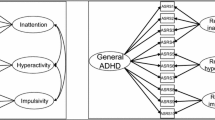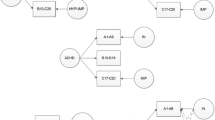Abstract
Three separate models have been proposed to describe the factor structure of attention deficit hyperactivity disorder (ADHD) in the past 20 years. The Diagnostic and Statistical Manual of Mental Disorders-III (DSM-III, 1980) proposed 3 separate factors of inattention, hyperactivity, and impulsivity. The DSM-III-R (1987) proposed a single factor. The DSM-IV (1994) described the disorder as having 2 factors: hyperactivity/impulsivity and inattention. The following 2 studies employed confirmatory factor analysis to compare each of these models and 3 alternative models. University students completed questionnaires that assessed each of the 18 symptoms listed in the DSM-IV for ADHD. The 3-factor model fit the data significantly better than each of the other models in both studies. These findings suggest that a 3-factor model of inattention, hyperactivity, and impulsivity describes adult ADHD symptoms better than current alternatives.
Similar content being viewed by others
REFERENCES
American Psychiatric Association. (1968). Diagnostic and statistical manual of mental disorders (2nd ed.). Washington, DC: Author.
American Psychiatric Association. (1980). Diagnostic and statistical manual of mental disorders (3rd ed.). Washington, DC: Author.
American Psychiatric Association. (1987). Diagnostic and statistical manual of mental disorders (3rd ed., revised). Washington, DC: Author.
American Psychiatric Association. (1994). Diagnostic and statistical manual of mental disorders (4th ed.). Washington, DC: Author.
Barkley, R. A. (1995). Taking charge of ADHD. New York: Guilford Press.
Beiser, M., Dion, R., &; Gotowiec, A. (2000). The structure of attention deficit and hyperactivity symptoms among Native and Non-Native elementary school children. Journal of Abnormal Child Psychology, 28(5), 425–437.
Bentler, P. M., &; Wu, E. J. C. (1995). EQS for Windows User's Guide. Encino, CA: Multivariate Software.
Conners, C. K., Erhardt, D., Epstein, J. N., Parker, J. D. A., Sitarenios, G., &; Sparrow, E. (1999). Self-ratings of ADHD symptoms in adults I: Factor structure and normative data. Journal of Attention Disorders, 3(3), 141–151.
Hudziak, J. J., Heath, A. C., Madden, P. F., Reich W., Bucholz, K. K., Slutske, W., et al. (1998). Latent class and factor analysis of DSMIVADHD: Atwin study of female adolescents. Journal of the American Academy of Child and Adolescent Psychiatry, 37(8), 848–857.
Shekim, W. O., Asarnow, R. F., Hess, E., Zaucha, K., &; Wheeler, N. (1990). A clinical and demographic profile of a sample of adults with Attention deficit hyperactivity disorder, residual state. Comprehensive Psychiatry, 31(5), 416–425.
Sherman, D. K., Iacono, W. G., &; McGue, M.K. (1997). Attention-deficit hyperactivity disorder dimensions: A twin study of inattention and impulsivity-hyperactivity. Journal of the American Academy of Child and Adolescent Psychiatry, 36(6), 745–753.
Smith, E. V., &; Johnson, B. D. (1998). Factor structure of the DSM-IV criteria for college students using the adult behavior checklist. Measurement and Evaluation in Counseling and Development, 31, 164–183.
Span, S. A., &; Earleywine, M. (1999). Cognitive functioning moderates the relation between hyperactivity and drinking habits. Alcoholism; Clinical and Experimental Research, 23(2), 224–229.
Weiss, G., &; Hechtman, L. (1993). Hyperactive children grown up: ADHD in children, adolescents, and adults (2nd ed.). New York: Guilford Press.
Wender, P. H. (1995). Attention-deficit hyperactivity disorder in adults. New York: Oxford University Press.
Author information
Authors and Affiliations
Corresponding author
Rights and permissions
About this article
Cite this article
Span, S.A., Earleywine, M. & Strybel, T.Z. Confirming the Factor Structure of Attention Deficit Hyperactivity Disorder Symptoms in Adult, Nonclinical Samples. Journal of Psychopathology and Behavioral Assessment 24, 129–136 (2002). https://doi.org/10.1023/A:1015396926356
Issue Date:
DOI: https://doi.org/10.1023/A:1015396926356




